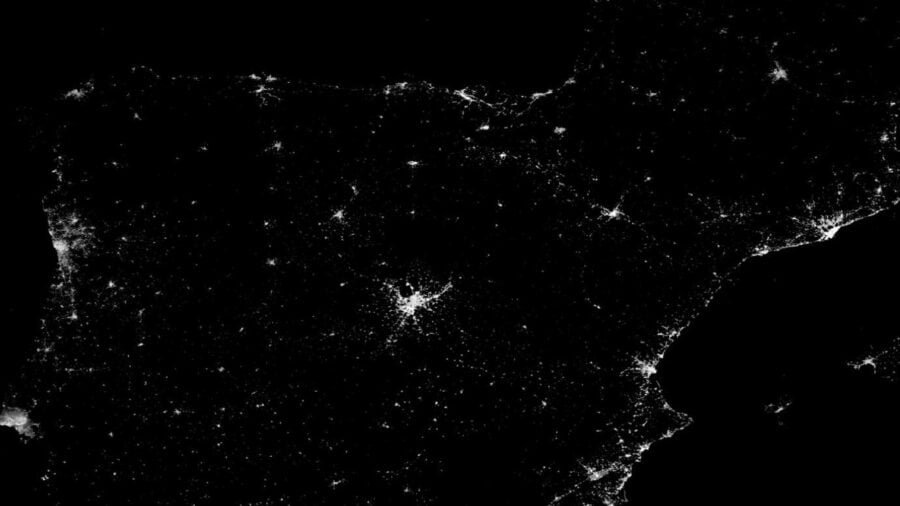Space-based monitoring tools have provided a unique perspective on the widespread power outage that affected Spain and Portugal on April 28, revealing both the extent of the blackout and the gradual recovery process. NASA’s polar satellites tracked the evolving situation throughout the night, delivering compelling visual evidence of infrastructure disruption that could transform how emergency responses are coordinated during similar events in the future.
The Night the Lights Went Out: Tracking Darkness from Above
As darkness descended upon the Iberian Peninsula on April 28, three NASA polar satellites – Suomi-NPP, NOAA-20, and NOAA-21 – captured a series of images documenting the blackout’s progression. The satellites, which circle Earth from pole to pole, made six passes over the affected regions between dusk and dawn, providing sequential snapshots of the evolving power grid situation.

The cloudless night allowed for exceptional clarity in the satellite imagery, revealing the stark contrast between areas with functioning electricity and those plunged into darkness.
“By overlaying the six satellite passes and applying NASA’s night-time algorithms, we can identify large green spots suddenly appearing and gradually fading,” explains Alejandro Sánchez de Miguel, researcher at the Instituto de Astrofísica de Andalucía (IAA-CSIC) and project lead of several ESA-supported initiatives monitoring light pollution from space.
Reading the Patterns of Recovery
The satellite images tell a compelling story of infrastructure resilience and recovery efforts. While electricity was restored in most territories by evening, some regions remained in darkness well into the early hours of the morning.
“The green dots indicate the absence of light, while white ones show areas with stable electricity supply. This distribution is consistent with electrical company reports and the gradual return to normality,” adds Sánchez de Miguel.
These observations align with official reports from electrical companies, providing independent verification of the blackout’s scope and the progressive restoration of power across different regions.
How Space Technology Transforms Emergency Response
- Real-time monitoring of infrastructure disruptions
- Independent verification of power company reports
- Visual data to prioritize repair efforts in hardest-hit areas
- Chronological mapping of recovery progress
- Scientific baseline data for studying human and ecological impacts
This widespread power outage demonstrates how space-based monitoring has evolved beyond scientific curiosity to become a practical tool for emergency response coordination. The visual data can help authorities assess infrastructure resilience, determine where to prioritize repairs, and coordinate emergency services more effectively.
When Disaster Becomes Scientific Opportunity
While power outages create significant challenges for affected populations, they also provide rare research opportunities. The European Space Agency (ESA) coordinates scientific infrastructure that could leverage such events as case studies to investigate disruptions to natural day-night rhythms and their effects on living organisms, including humans.
Most Europeans live under light-polluted skies, with artificial illumination dominating the night. For an astronaut looking out of the International Space Station windows, city lights typically appear brighter than stars. Events like the Iberian blackout create natural experiments that help establish thresholds for future monitoring systems.
ESA contributes to the Night Watch project, a European multispectral mission studying nighttime light emissions, and supports initiatives such as Cities at Night, which utilizes astronaut photography to study light pollution patterns globally.
From Monitoring to Prediction
What happens when we can not only observe blackouts but potentially predict vulnerable infrastructure before failures occur? The data collected from this event will help inform more sophisticated monitoring systems that might one day provide early warnings of potential grid instabilities.
The ESA is building on these capabilities through projects like the Rosetta and OSIRIS archive, which provides radiometric validation material for upcoming European night observation missions. These initiatives represent the next generation of space-based infrastructure monitoring that will further enhance our ability to respond to and potentially prevent large-scale disruptions.
As our dependence on electrical infrastructure grows, the view from above offers not just fascinating images but critical insights that could help make our power systems more resilient in the face of future challenges. From disaster response to scientific research on light pollution, the night the lights went out in Spain and Portugal will continue to illuminate our understanding of modern infrastructure vulnerabilities.
Discover more from European Space Agency Tracker
Subscribe to get the latest posts sent to your email.
